One of the most common questions I'm being asked is "how much should I be feeding my cows?" The strengthening drought conditions have seen an increase in people commencing feeding programs for their cattle. Part of a feeding program is working out how much feed you need to meet your livestock requirements.
The other key part of a program is working out your budget and the length of time you are prepared to feed stock. Ideally you should be thinking about windows to sell stock off, either to processors or to restockers in areas unaffected by drought. In most cases these destinations can't take stock immediately, and by booking them in for sale now, at least you have a timeline for feeding.
So when should you start feeding your cattle? And most importantly how much should you be feeding them?
Once your pasture has fallen below 1200kg / Dry Matter (DM) / Ha your cattle need to be fed. As I've written in these posts before, once pasture is at or below this amount, feeding with protein supplements is both ineffective and wasteful.
At this stage of pasture, you should be concentrating on feeding your cattle to meet their daily energy requirements. This means choosing and providing a feed which is suitable and capable of providing the energy your animals need.
So how do you work out the energy levels of the feeds you might choose? There are a couple of ways. The most accurate is to take a sample and send it for analysis. The results will provide you with the energy levels in Mega Joules (MJ) of Metabolisable Energy (ME) as well as Crude Protein (CP%). You can ask for other test results, but these two are the most important.
The other option is to refer to standard ranges for feeds which have already been tested. These will give you a guide and can help identify suitable feeds for a program. You can find these ranges on the NSW DPI website under Nutritive values of feeds (database).
Establishing the energy levels of the feed is the first step. The second is to determine the amount you need to feed per head, per day. The easiest option is to use this chart, which can be downloaded from the NSW DPI website.
To use this chart all you will need is a ruler, and to know both the average weight of your cows and the energy levels of the feed you intend to use.
When you know the weight of your cattle and the energy of the feed, draw a line from the weight through the feed and to the feed amount on the right hand side of the chart.
This will give you the amount of feed your cattle will require per head per day. You will need to allow for the moisture in the feed. You do this by multiplying the amount you have worked out off the chart by 100. You then divide that figure by the Dry Matter to give yourself the daily as fed amount for your stock.
Depending on the class of stock you are feeding, you may need to adjust the as fed levels. For instance a cow which is 6 months pregnant will need her daily ration increased by 20%; at 8 months pregnant its an increase of 40% and a lactating cow its an increase of 60%.
Taking the time to work out the amount of feed you need per head per day to meet your cattle's energy requirements is essential if you are to feed cattle properly. Depending on the feed you select, you may need to consider options such as how to feed it out, how to store it and if it is the most cost effective feed option available to you.
Doing some homework first will pay off in the longer term particularly if you can use it to calculate a program based on time and budget.






























